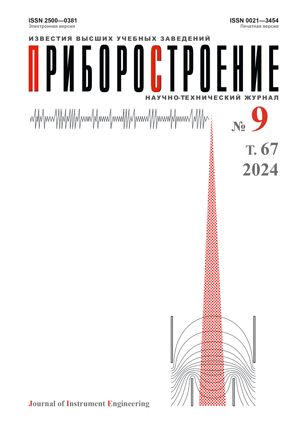
The journal "Journal of Instrument Engineering" publishes materials related to the theory, technology, practice of calculation and application of all types of modern automatic and automated devices and instrument complexes: information-measuring; gyroscopic; systems for controlling objects, physical and technological processes; navigation and motion control; computer technology, informatics and neurocomputers; precision mechanics; electronic, electromagnetic, optical and optoelectronic devices
Current issue
SYSTEM ANALYSIS, CONTROL, AND INFORMATION PROCESSING
A new algorithm for controlling unstable linear systems with input delay is presented. Unlike known analogs, a control law is synthesized that is a modification of the Smith predictor with the simplest implementation that does not require complex integration methods. A fairly effective solution to the problem of stabilizing a closed system is proposed, ensuring the boundedness of all state variables and exponential stability of the equilibrium position.
The problem of fault detecting and localizing of inertial system sensors used by an autonomous underwater vehicle during navigation is considered. A comparative analysis of solutions based on various machine learning models is proposed. Directional mismatch signal generators are built on the basis of full-order observers to detect and localize failures of sensors used to measure the linear and angular velocity of an underwater vehicle model. The dynamics of the autonomous underwater vehicle model moving at a constant longitudinal velocity in a horizontal plane is considered. The conditions are formulated to ensure the correct detection of failures and the sensitivity of mismatch generators to the failure of an individual sensor. The functions used as features for the proposed machine learning methods are designed. The setup was performed and a comparative analysis of the effectiveness of various machine learning models in the task of diagnosing sensors are carried out. The results of computer modeling are presented, demonstrating the high accuracy of fault detection during data augmentation for training due to mismatch signals.
The problem of improving the safety of launching spacecraft into orbit in conditions of emergency situations during the flight phase of the first and second stages of the launch vehicle, when the consequences of emergency launch of space rocket cause the most significant damage to the ground infrastructure and the environment in the vicinity of the launch paths, is studied. The possibility is substantiated and a method is proposed to reduce damage from the consequences of emergency launches, based on a retrospective analysis of the features of emergency situations arising on board launch vehicles, formation of a base of scenarios for their development using digital twins technology, promptly determining, based on the results of neural network processing of telemetric information, situations that allow the possibility of correcting the output program, and the implementation of a rational option for correcting the withdrawal program in order to minimize the damage from the consequences of an emergency situation.
Robust visual localization in real-world conditions remains a challenging task, particularly in the presence of dynamic objects and transient distractors. While neural scene representations such as 3D Gaussian Splatting (3DGS) or NeRF offer compact encoding of scene geometry and appearance, they are sensitive to static world assumption due to their reliance on photometric consistency. In this work, we present a robust visual localization framework that leverage 3DGS with semantic-aware masking strategy to improve accuracy in dynamic scenes. Our approach extends GSplatLoc, which is a two-stage pipeline: first integrate dense and lightweight keypoint descriptors from the XFeat network into the 3DGS representation, enabling efficient 2D-3D matching for coarse pose estimation. To mitigate the impact of dynamic distractors, we incorporate semantic masks generated from a classifier that utilizes a pre-trained diffusion model to exclude inconsistent regions during 3D modeling. In the second stage, the initial pose is refined using a rendering-based photometric alignment loss. Experiments on both indoor and outdoor dynamic benchmarks demonstrate that our method achieves superior performance compared to baseline method in challenging dynamic environments.
METHODS AND INSTRUMENTS FOR ANALYSIS AND MONITORING OF THE NATURAL ENVIRONMENT, SUBSTANCES, MATERIALS AND PRODUCTS
A multi-sign method of laser control of the fire situation in the forest is proposed. In the process of burning in the forest, a significant amount of greenhouse gases and heat is released into the atmosphere. The main gases released are carbon dioxide, methane, nitrogen oxide, and carbon monoxide. An overview of publications on methods of early detection of forest fires is presented. An approach to improvement the sensitivity of fire detection in a forest by means of simultaneously registering all emitted gases is considered. The approach makes use of the differential absorption method for each gas with an integrated laser node emitting at several specially selected wavelengths. The optimization of the proposed method is carried out, as a result of which recommendations are developed for the construction of a highly sensitive system for early detection of forest fires at specified energy consumption.
DESIGN AND PRODUCTION TECHNOLOGY OF INSTRUMENTS
The technology of forming thin-film functional coatings on flat surfaces of precision accelerometers by magnetron sputtering is considered using examples of aluminum deposition in the manufacture of a base plate for a sensitive element of a micromechanical accelerometer. A mathematical model of uniform thickness coating formation on a flat surface is presented, and the main significant parameters of the spraying process are determined. The optimized parameter is the orientation angle of the substrate relative to the magnetron target, and the optimization criterion is the minimum value of the standard deviation of the coating thickness. The effectiveness of the proposed model is confirmed by the practical results of studies of the characteristics of the coatings obtained.
The application of the quasi-closed space effect in the formation of conductive films on ceramics by magnetron sputtering is discussed. This method provides the most flexible possibilities for varying process conditions and thereby influencing the characteristics of the resulting films. One of the process conditions of magnetron sputtering that affects the homogeneity of the composition of the resulting film is the formation of a quasi-closed space in the film deposition zone. A variant of implementing a quasi-closed space is proposed, and a series of copper films are formed using a quasi-closed space and without it. Adhesion and specific surface resistance of the films are determined, and the thickness is determined and the homogeneity of the structures obtained is estimated using scanning electron microscopy. The reduction in the number of defects in conductive films is associated with a higher pressure in the film formation zone in relation to the rest of the vacuum chamber space when implementing a quasi-closed space; the difference in pressure and plasma-forming gas allows, on the one hand, to stabilize the main characteristics of the magnetron discharge, and consequently the film formation process, and on the other hand, to minimize the possibility of including various types of contaminating inclusions in the film structure.
BRIEF NOTES
Results of a study of the spectral transmission and shape of the working surfaces of glasses after their hardening by chemical etching are presented. It is revealed experimentally that the spectral transmission of the glasses does not change, and the shape of the working surfaces deteriorates. Recommendations are given on the use of transparent armor to protect optoelectronic devices.
ISSN 2500-0381 (Online)




























